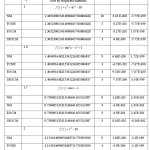Second Derivative Free Eighteenth Order Convergent Method for Solving Non-Linear Equations
V.B. Kumar Vatti1*, Ramadevi Sri2 and M.S. Kumar Mylapalli2
1Dept. of Engineering Mathematics, Andhra University, Visakhapatnam, India.
2Dept. of Mathematics, Gitam University, Visakhapatnam, India.
Corresponding author Email: drvattivbk@yahoo.co.in
DOI : http://dx.doi.org/10.13005/ojcst/10.04.19
Article Publishing History
Article Received on : 14-12-2017
Article Accepted on : 30-12-2017
Article Published : 05 Jan 2018
Article Metrics
ABSTRACT:
In this paper, the Eighteenth Order Convergent Method (EOCM) developed by Vatti et.al is considered and this method is further studied without the presence of second derivative. It is shown that this method has same efficiency index as that of EOCM. Several numerical examples are given to illustrate the efficiency and performance of the new method.
AMS Subject Classification: 41A25, 65K05, 65H05.
KEYWORDS:
Convergence analysis; Higher order convergence; Iterative method; Nonlinear equation; Newton’s method
Copy the following to cite this article:
Vatti V. B. K, Sri R, Mylapalli M. S. K. Second Derivative Free Eighteenth Order Convergent Method for Solving Non-Linear Equations. Orient.J. Comp. Sci. and Technol;10(4)
|
Copy the following to cite this URL:
Vatti V. B. K, Sri R, Mylapalli M. S. K. Second Derivative Free Eighteenth Order Convergent Method for Solving Non-Linear Equations. Orient. J. Comp. Sci. and Technol;10(4). Available from: http://www.computerscijournal.org/?p=7325
|
Introduction
It is well known that a wide class of problems, which arises in diverse disciplines of mathematical and engineering science can be studied by the nonlinear equation of the form
f (x) = 0 (1.1)
Where f : D ⊂ R → R is a scalar function on an open interval D and f (x) may be algebraic, transcendental or combined of both. The most widely used algorithm for solving (1.1) by the use of value of the function and its derivative is the well known quadratic convergent Newton’s method (NM) given by

starting with an initial guess x0 which is in the vicinity of the exact root x* The efficiency index of Newton’s method is 2√2 = 1.4142
The Extrapolated Newton’s method (ENM) suggested by V.B. Kumar, Vatti et.al.,11 which is developed by extrapolating Newton’s method (1.2) introducing a parameter ‘αn’ given by
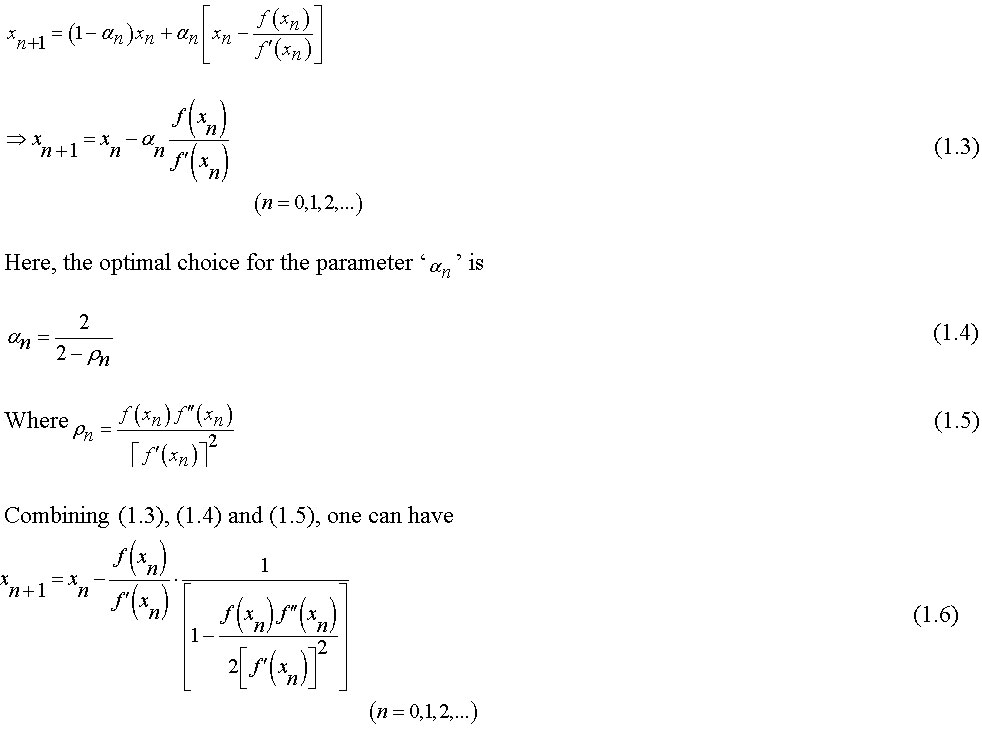
Which is same as Halley’s method having third order convergence which requires three functional evaluations. The efficiency index of this method is 3√3 = 1.4422
A three step Predictor-corrector Newton’s Halley method (PCNH) suggested by Mohammed and Hafiz,10 is given by:
For a given x0 compute xn+1 by using

This method has eighteenth order convergence and its efficiency index is 8√18 = 1.4352
The three step Eighteenth Order Extrapolated Newton’s method(EOCM) developed by Vatti et.al.,12 is given by:
For a given x0, compute xn+1 by the iterative schemes
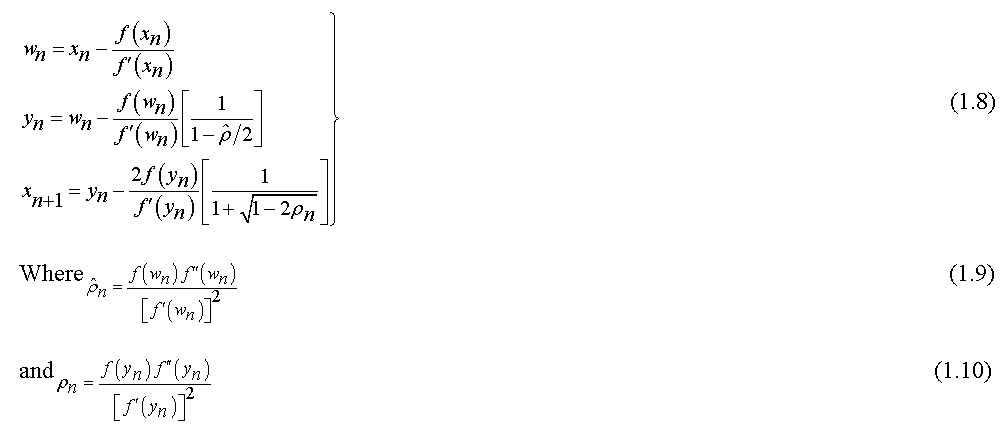
This method has eighteenth order convergence and its efficiency index is 8√18 = 1.4352
In section 2, we consider the Second derivative free Eighteenth Order Extrapolated Newton’s method and discuss the convergence criteria of this method in section 3. Few numerical examples are considered to show the superiority of this method in the concluding section.
Second Derivative Free Eighteenth Order Convergent Method (SEOCM):
Considering the Eighteenth Order Extrapolated Newton’s method(EOCM) (1.8) with (1.9) and (1.10), and expanding f (wn) about xn we obtain.
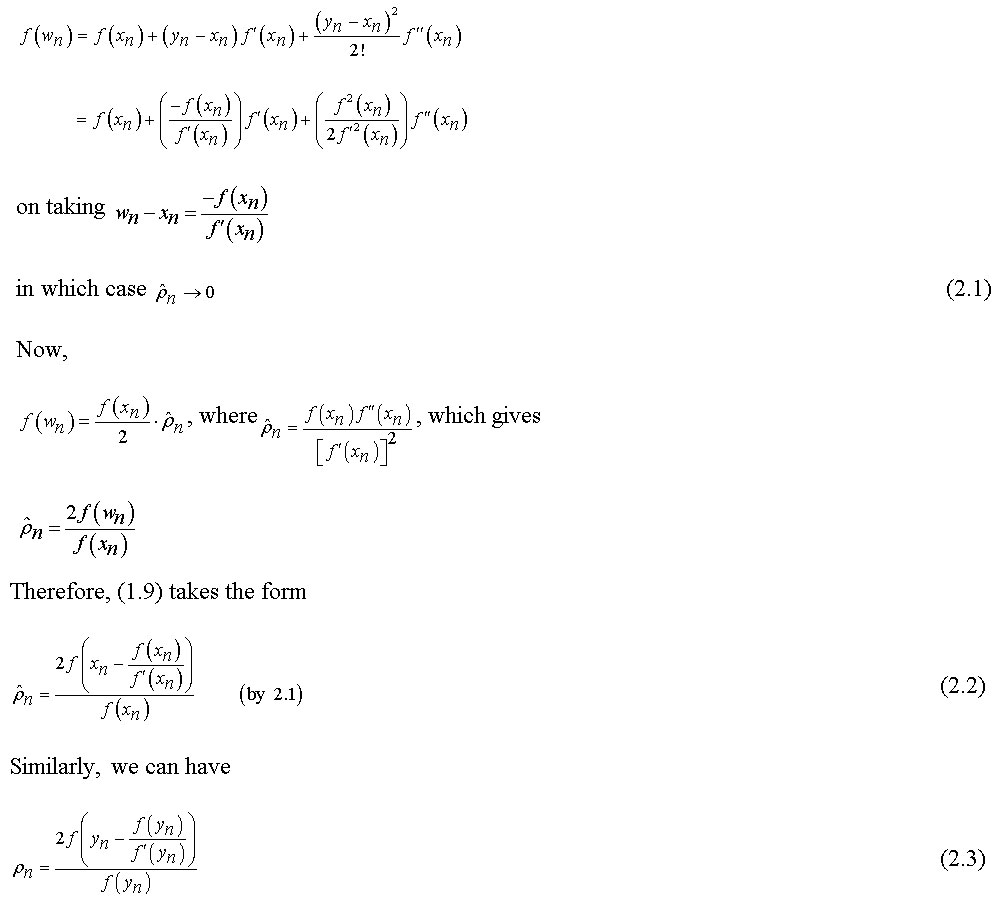
and rewriting equations (2.2), (2.3) in (1.8), we thus have the following algorithm:
Algorithm 2.1: For a given x0, compute xn+1 by the iterative schemes

Where pn and pn are as given in (2.2) and (2.3).
This algorithm can be called as Second derivative free Eighteenth Order Extrapolated Newton’s method (SEOCM) and it requires eight functional evaluations.
Convergence Criteria
Theorem 3.1.
Let x* ∈ D be a single zero of a sufficiently differentiable function f : D ⊂ R → R for an open interval D and let x0 be in the vicinity of x* then the algorithm (2.1) has eighteenth order convergence.
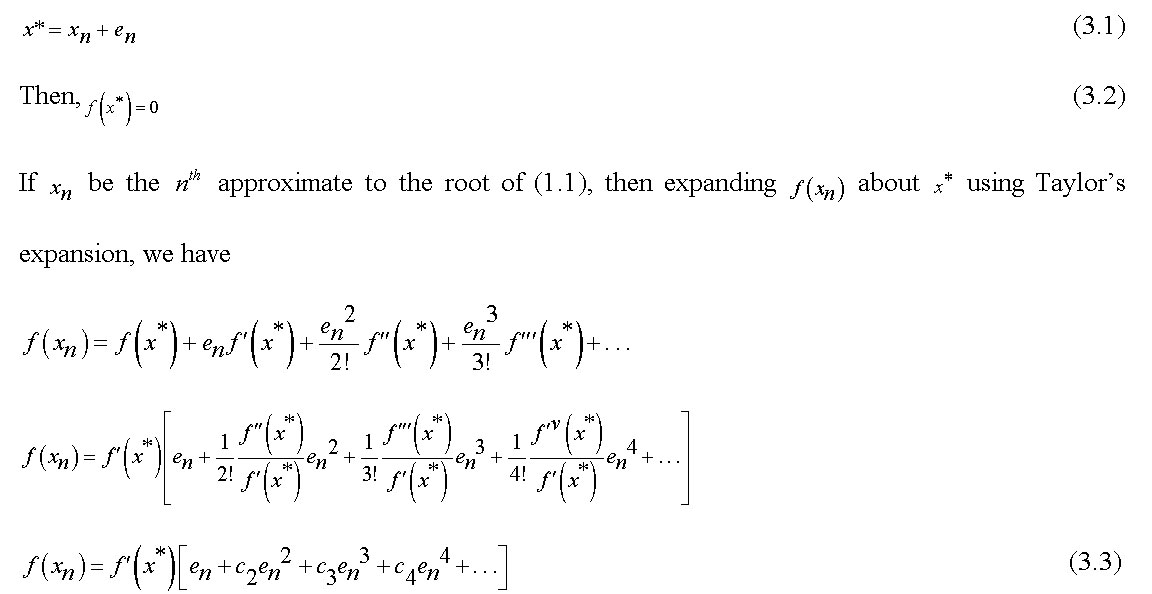
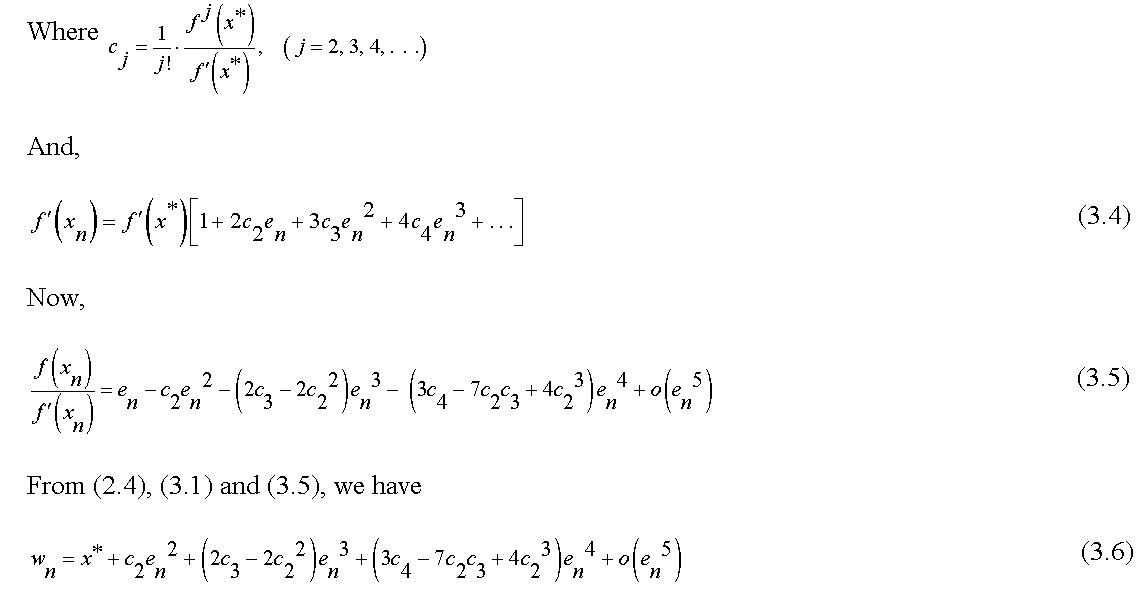
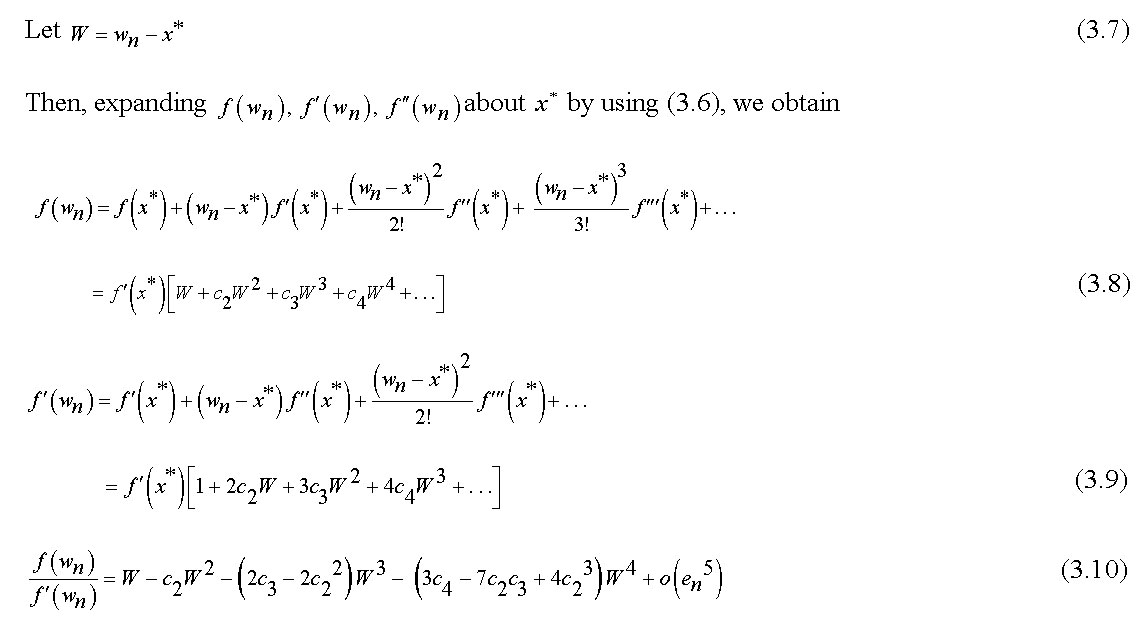
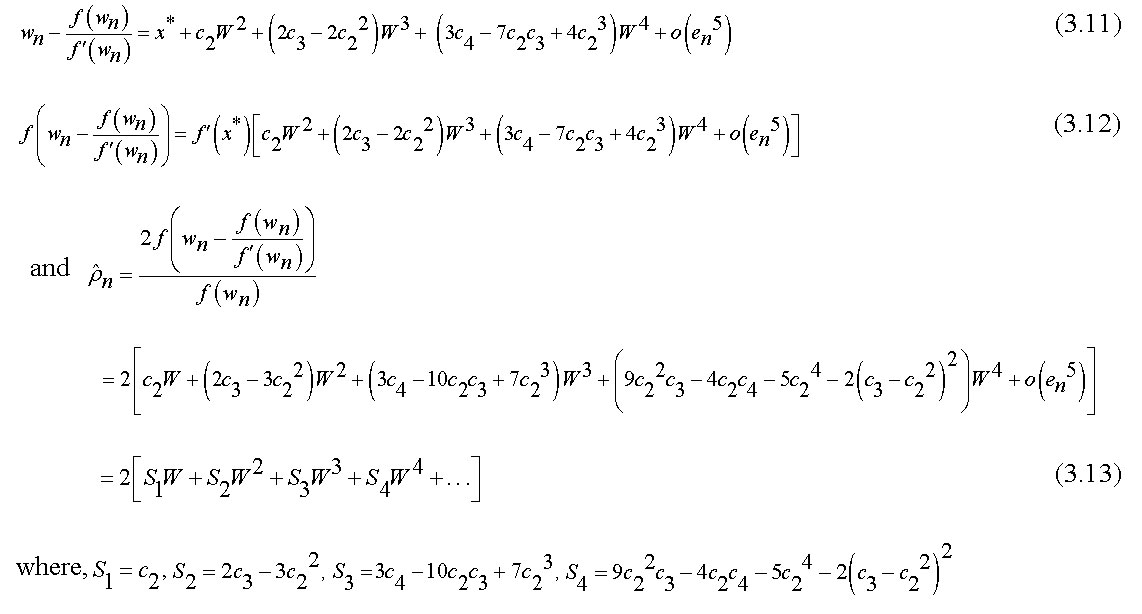
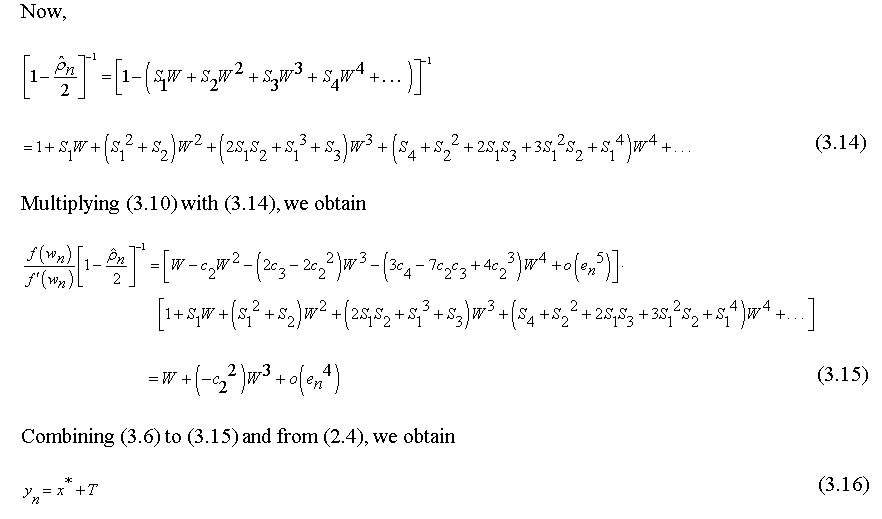
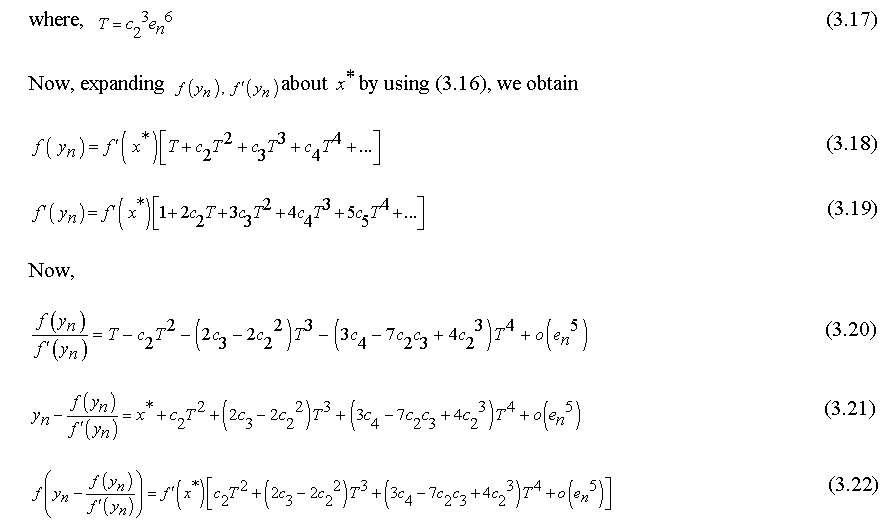
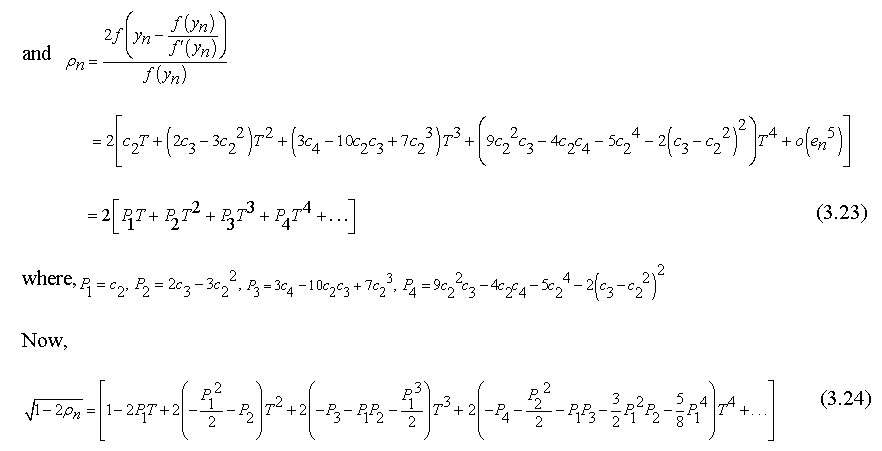
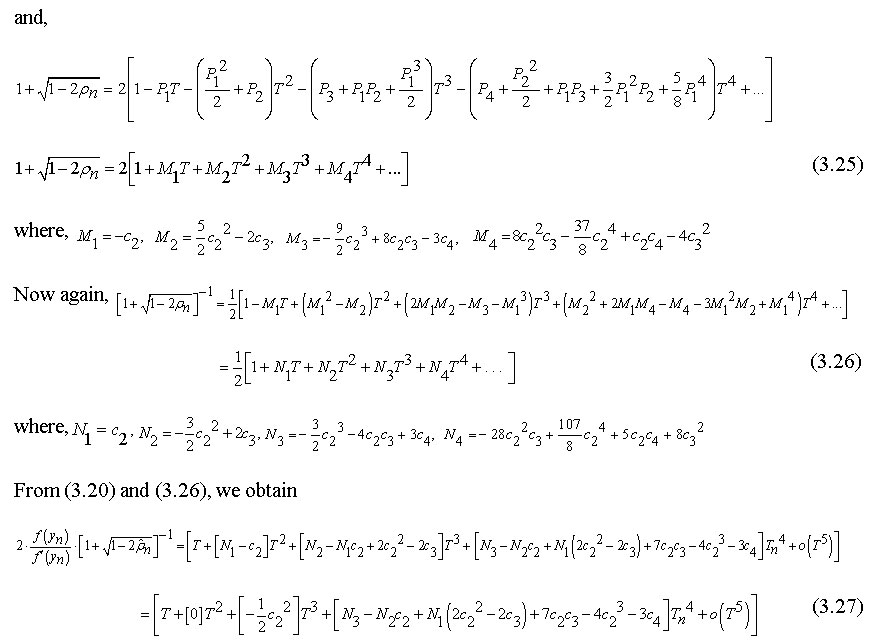
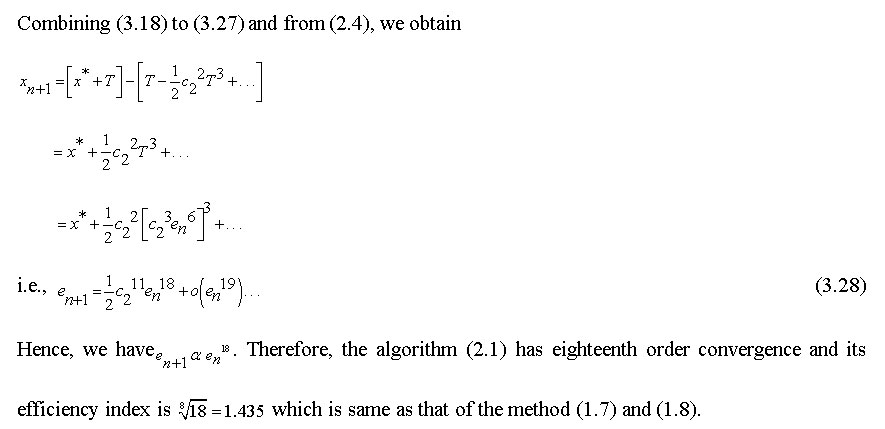
Numerical Examples
We consider the same examples considered by Mohammed and Hafiz10 and V.B. Kumar, Vatti et.al.,13 and compared EOCM with NM and PCNH methods. The computations are carried out by using mp math-PYTHON software programming and comparison of number of iterations for these methods are obtained such that |xn+1– xn| <10-201 and |f(xn+1)|<10-201.
It is evident from these tabulated values that SEOCM is superior to the methods (1.2) and (1.7) considering the number of iterations and accuracy and the rate at which SEOCM converged and the convergence rate is almost same as that of the method (1.8). Of these methods, SEOCM is free from second derivatives.
References
- I.K. Argyros, S.K. Khattri, An improved semi local convergence analysis for the Chebyshev method.Journal of Applied Mathematics and computing.2013;42:1:(2):509-528, doi: 10.1007/s12190-013-0647-3.
- M.A. Hafiz, Solving nonlinear equations using steffensen-type methods with optimal order of convergence. Palestine Journal of Mathematics.2014;3(1):113-119.
- M.A. Hafiz, A new combined bracketing method for solving nonlinear equations. Journal of Mathematical and Computational Science.2013;3(1).
- M.A. Hafiz, S.M.H. Al-Goria, Solving nonlinear equations using a new tenth-and seventh- order methods free from second derivative.International Journal of Differential Equations and Applications.2013;12(3):
169-183,2013, doi: 10.12732/ijdea.v12i3.1344.
- S.K. Khattri, Torgrim Log, Constructing third-order derivative-free iterative methods. Int. J. Comput. Math. 2011;88(7):1509-1518 doi: 10.1080/00207160.2010520705.
- S.K. Khattri. Quadrature based optimal iterative methods with applications in high precision computing. Numer. Math. Theor. Meth. Appl.2012;5:592-601.
- S.K. Khattri, Trond Steihaug, Algorithm for forming derivative-free optimal methods. Numerical Algorithms.2013, doi: 10.1007/s11075-013-9715-x.
- Mohamed S.M. Bahgat, M.A. Hafiz. New two-step predictor-corrector method with ninth order convergence for solving nonlinear equations. Journal of Advances in Mathematics.2013;2:432-437.
- Khalida Inayat Noor, Muhammad Aslam Noor, Shaher Momani. Modified Householder iterative methods for nonlinear equations”. Applied Mathematics and Computation.2007;190:1534-1539, doi: 10.1016/j.amc.2007.02.036.
- Mohamed S.M. Bahgat, M.A. Hafiz. Three-step iterative method with eighteenth order convergence for solving nonlinear equations. Int. Journal of Pure and Applied Mathematics.2014;93(1):85-94.
- Vatti V.B.Kumar, Mylapalli M. S. Kumar, Katragadda A. Kumari. Extrapolated Newton-Raphson Method. Math. Educ. 2009;43(1)103-108.
- Vatti V. B. K, Sri R, Mylapalli M. S. K. Eighteenth Order Convergent Method for Solving Non-Linear Equations. Orient.J. Comp. Sci. and Technol.2017;10(1):144-150.
- Vatti V. B. K, Ramadevi Sri, Mylapalli M. S. K. Two Step Extrapolated Newton’s Method with High Efficiency Index. Journal of Advanced Research in Dynamical and Control Systems.2017;9(5):08-15.

This work is licensed under a Creative Commons Attribution 4.0 International License.
















